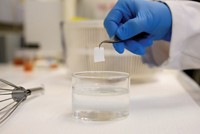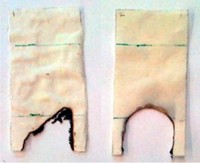Advertisement
Grab your lab coat. Let's get started
Welcome!
Welcome!
Create an account below to get 6 C&EN articles per month, receive newsletters and more - all free.
It seems this is your first time logging in online. Please enter the following information to continue.
As an ACS member you automatically get access to this site. All we need is few more details to create your reading experience.
Not you? Sign in with a different account.
Not you? Sign in with a different account.
ERROR 1
ERROR 1
ERROR 2
ERROR 2
ERROR 2
ERROR 2
ERROR 2
Password and Confirm password must match.
If you have an ACS member number, please enter it here so we can link this account to your membership. (optional)
ERROR 2
ACS values your privacy. By submitting your information, you are gaining access to C&EN and subscribing to our weekly newsletter. We use the information you provide to make your reading experience better, and we will never sell your data to third party members.
Materials
Ionic Liquids Improve Separations
Scientists discuss recent addition to types of stationary phases available for gas chromatography
by Celia Henry Arnaud
April 2, 2012
| A version of this story appeared in
Volume 90, Issue 14

Two years ago, room-temperature ionic liquids became the first new type of commercial stationary phase to hit gas chromatography in more than three decades. Scientists have known about ionic liquids for more than a century, but their usefulness for GC wasn’t proven until 2005. The first commercial ionic liquid stationary phases were introduced by Supelco, a division of Sigma-Aldrich, in 2010.
In a Pittcon symposium, separation scientists described the use of ionic liquids as GC stationary phases and as matrices for matrix-assisted laser desorption/ionization mass spectrometry (MALDI-MS).
COVER STORY
Ionic Liquids Improve Separations
Ionic liquids are salts that are liquid at room temperature. They generally consist of a bulky organic cation, such as 1-butyl-3-methylimidazolium, paired with an anion, which can range from simple halides to bulky compounds such as triflate.
Several characteristics of room-temperature ionic liquids make them particularly attractive as GC stationary phases, said Daniel W. Armstrong, a professor of chemistry and biochemistry at the University of Texas, Arlington, who was the first to show that ionic liquids could be used as stationary phases. Foremost among these properties are their high thermal stability and high viscosity. Ionic liquids are stable over a broad temperature range, from –40 °C to more than 450 °C. Triflate-containing ionic liquids have particularly good thermal stability, Armstrong said. That thermal stability translates into columns that last longer before “bleeding” or degrading. Their high viscosity means they are easy to use as coatings for columns, said Leonard M. Sidisky, a scientist at Supelco.
Ionic liquid columns are more polar than any other commercially available GC columns, Armstrong said. Because they provide a separation that has selectivity different from those of other stationary phases, they could play a big role in multidimensional GC, he said. The separation selectivity of ionic liquid media can be tweaked by changing the cation, anion, or both.
A particular strength of ionic liquid stationary phases, Armstrong said, is that they can be used for the analysis of water—not just compounds in water, but water in other solvents. Armstrong’s group analyzed the water content of 50 solvents. The detection limit using GC with ionic liquid columns was 5,000-fold better than the detection limit of the Karl Fischer method, the conventional titration method for quantifying trace amounts of water.
Luigi Mondello, a professor in the analytical and food chemistry division at the University of Messina, in Italy, has done much to characterize the chromatographic performance of ionic liquid columns. Compared with other columns, ionic liquid columns can be run at higher temperatures, he said. The observed number of theoretical plates of such columns, a measure of column efficiency, is in good agreement with theoretical estimates of those values, he said.
Mondello has used ionic liquid columns to separate fatty acid methyl esters. The ability to resolve cis and trans fatty acids is particularly important in food analysis because of labeling requirements for trans fats. With a 100-meter ionic liquid column, Mondello fully separated 20 out of 22 cis/trans fatty acids.
Supelco’s Sidisky showed how changes in the ionic liquid translate into changes in the separation of a test mixture of compounds. The retention of an aliphatic compound like tridecane shifts relative to that of an aromatic compound like toluene depending on the polarity of the stationary phase, he said. Similarly, increasing the polarity changes the retention times of the BTEX (benzene, toluene, ethylbenzene, and xylene) components of gasoline relative to one another. The better elution control provided by ionic liquids can translate into better separations.
In the case of polychlorinated biphenyls, Sidisky said, one of the ionic liquid stationary phases seems to be ideal. Most separations of PCBs are plagued by coelution, particularly of compounds that can’t easily be distinguished in other ways. But the few PCBs that coelute when a particular ionic liquid stationary phase is used can be differentiated by mass.

Ionic liquids, including polymeric ionic liquids, can be used not only as GC stationary phases but also as coatings for solid-phase microextraction fibers, according to Jared L. Anderson, a chemistry professor at the University of Toledo, in Ohio. Whereas most ionic liquids used in GC are dications, Anderson uses monocationic linear polymeric ionic liquids. Depending on how the polymer is functionalized, such ionic liquids can be used on microextraction fibers to preconcentrate a range of analytes including hydrocarbons, carbon dioxide, genotoxic impurities, and fatty acid methyl esters. The polymeric ionic liquid coatings are quite resistant to damage from complex matrices, Anderson said, making them particularly useful for environmental analysis. Fibers coated with specially designed polymeric ionic liquids can be used for high-temperature headspace extraction as well as for monitoring the enantioselectivity of chiral syntheses, he said.
Rico E. Del Sesto and his colleagues at Los Alamos National Laboratory have shown that they can get double duty out of ionic liquids by using them as both an extraction solvent and a MALDI matrix. They found such a combination to be effective for forensic analysis of wool textiles. Many such textiles are dyed in small batches, and the dye signature can help pinpoint the origin of the textile.
Wool is tough to break down, and many analytical methods destroy the dye along with the wool. Ionic liquids are ideal for breaking down the keratin in wool while simultaneously extracting the dye. Del Sesto and his colleagues synthesized phosphonium ionic liquids that contained ferulate, α-cyano-4-hydroxycinnamate, or 2,5-dihydroxybenzoate anions. Those anions are often used in conventional MALDI matrices, and the resulting ionic liquids can be used instead of a conventional MALDI matrix.
Del Sesto and his colleagues used the ionic liquids to analyze different textiles and dyes, with chloride-based ionic liquids being most effective at disrupting the wool structure and extracting the dyes. Because the dyes absorb ultraviolet light from the MALDI laser, the extract can be used as its own MALDI matrix. In one textile, Del Sesto and his colleagues identified the synthetic dye acid red 51 and a mothproofing agent. In another sample, they quantified a natural dye called cota.
“One thing is clear, and it is that ionic liquids are going to play an important role in the future of separations,” Armstrong told C&EN. “This includes everything from sample preparation to high-end analytical instrumental techniques to process-scale purifications. The average person may not realize that many of these techniques and processes are already in place and many more are in the development stage.”





Join the conversation
Contact the reporter
Submit a Letter to the Editor for publication
Engage with us on Twitter